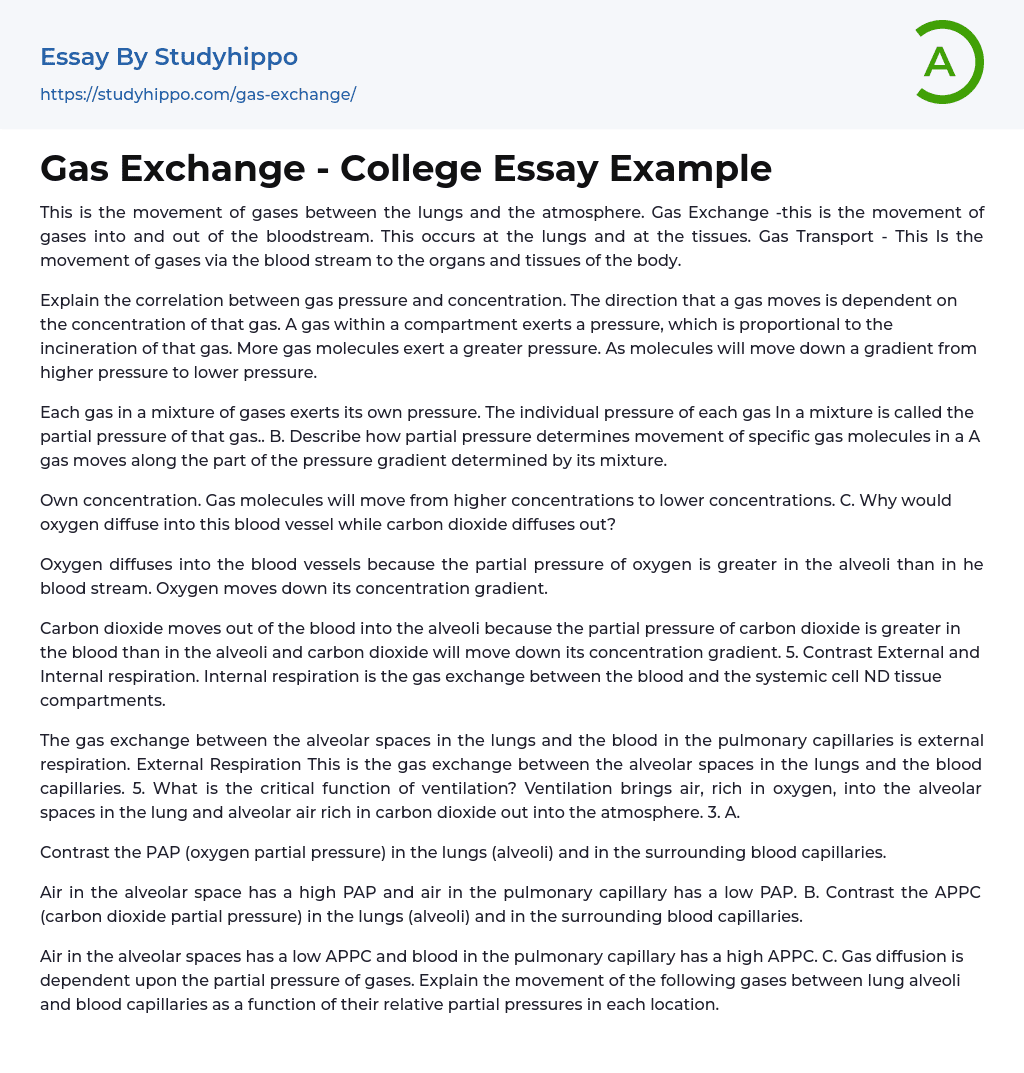This is the movement of gases between the lungs and the atmosphere. Gas Exchange -this is the movement of gases into and out of the bloodstream. This occurs at the lungs and at the tissues. Gas Transport - This Is the movement of gases via the blood stream to the organs and tissues of the body.
Explain the correlation between gas pressure and concentration. The direction that a gas moves is dependent on the concentration of that gas. A gas within a compartment exerts a pressure, which is proportional to the incineration of that gas. More gas molecules exert a greater pressure. As molecules will move down a gradient from higher pressure to lower pressure.
Each gas in a mixture of gases exerts its own pressure. The individual pressure of each gas In a mixture is called the partial pressure of that gas.. B. Desc
...ribe how partial pressure determines movement of specific gas molecules in a A gas moves along the part of the pressure gradient determined by its mixture.
Own concentration. Gas molecules will move from higher concentrations to lower concentrations. C. Why would oxygen diffuse into this blood vessel while carbon dioxide diffuses out?
Oxygen diffuses into the blood vessels because the partial pressure of oxygen is greater in the alveoli than in he blood stream. Oxygen moves down its concentration gradient.
Carbon dioxide moves out of the blood into the alveoli because the partial pressure of carbon dioxide is greater in the blood than in the alveoli and carbon dioxide will move down its concentration gradient. 5. Contrast External and Internal respiration. Internal respiration is the gas exchange between the bloo
and the systemic cell ND tissue compartments.
The gas exchange between the alveolar spaces in the lungs and the blood in the pulmonary capillaries is external respiration. External Respiration This is the gas exchange between the alveolar spaces in the lungs and the blood capillaries. 5. What is the critical function of ventilation? Ventilation brings air, rich in oxygen, into the alveolar spaces in the lung and alveolar air rich in carbon dioxide out into the atmosphere. 3. A.
Contrast the PAP (oxygen partial pressure) in the lungs (alveoli) and in the surrounding blood capillaries.
Air in the alveolar space has a high PAP and air in the pulmonary capillary has a low PAP. B. Contrast the APPC (carbon dioxide partial pressure) in the lungs (alveoli) and in the surrounding blood capillaries.
Air in the alveolar spaces has a low APPC and blood in the pulmonary capillary has a high APPC. C. Gas diffusion is dependent upon the partial pressure of gases. Explain the movement of the following gases between lung alveoli and blood capillaries as a function of their relative partial pressures in each location.
- Action Potential essays
- Blood essays
- Body essays
- Brain essays
- Childbirth essays
- Eye essays
- Glucose essays
- Heart essays
- Human Physiology essays
- Immune System essays
- Kidney essays
- Muscle essays
- Nervous System essays
- Neuron essays
- Poison essays
- Puberty essays
- Sense essays
- Skeleton essays
- Skin essays
- Adaptation essays
- Adventure essays
- Adversity essays
- Aging essays
- Alcohol essays
- Barbie Doll essays
- Beauty essays
- Care essays
- Carpe diem essays
- Change essays
- Chess essays
- Chicken essays
- Choices essays
- Contrast essays
- Crops essays
- Development essays
- Dream essays
- Evil essays
- Experience essays
- Family essays
- Farm essays
- Fire essays
- First Love essays
- Focus essays
- Greed essays
- Hero essays
- Holiday essays
- House essays
- Housing essays
- Humility essays
- Humor essays




